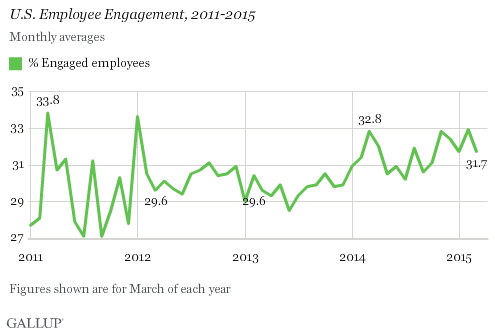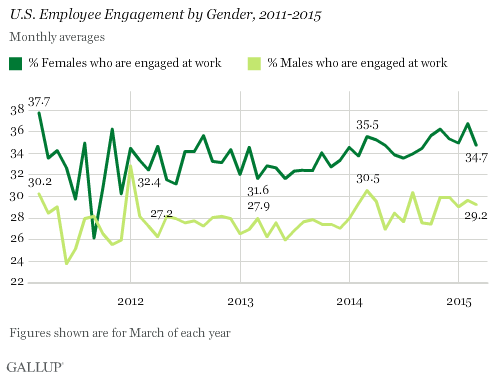U.S. Employee Engagement Dips in March
Friday, April 10th, 2015
The percentage of U.S. workers engaged in their jobs fell to an average of 31.7% in March, down from an average of 32.9% in February. The latest figure also trails the March 2014 average of 32.8%.

The employee engagement average, however, for the first quarter of 2015 is slightly higher than the average for the first quarter of 2014 (32.1% vs. 31.7%).
The March 2015 estimate is based on Gallup Daily tracking interviews conducted with 7,112 adults working for an employer. Gallup categorizes workers as engaged based on their responses to key workplace elements that it has found predict important organizational performance outcomes. Gallup's extensive research shows that engagement is strongly connected to business outcomes essential to an organization's financial success, including productivity, profitability and customer satisfaction. Engaged employees are also the ones who are the most likely to drive innovation, growth and revenue that their companies need.
Females More Engaged Than Males
Female workers are significantly more engaged in their jobs than males. In March, 34.7% of females were engaged, compared with 29.2% of males. The stark contrast in engagement among males and females is consistent with Gallup's historical tracking. Gallup began its daily survey of U.S. workplace engagement in January 2011 and only once -- in September 2011 -- has the engagement of male workers surpassed the engagement of female workers. Typically, female workers are five to six percentage points more engaged than male workers. In part, this difference may be attributable to the types of jobs that females and males tend to hold. Males are more likely to work in jobs that research shows are less engaging, such as production jobs.

Bottom Line
The recent drop in employee engagement follows a three-year average high on the measure in February. Employee engagement has only surpassed 33% twice since Gallup began its daily survey. At its peak, the rate of U.S. employee engagement reached 33.8% in March 2011, followed by 33.6% in January 2012. Although the February 2015 figure came close to breaking the barrier at 32.9%, engagement retreated again in March. Despite this backslide, employee engagement is still currently higher than it was at this time in 2014.


